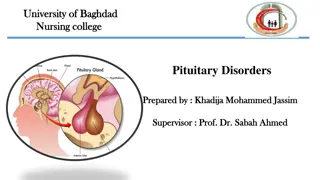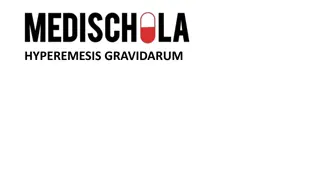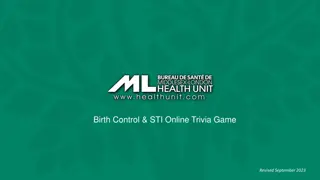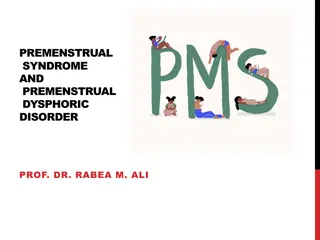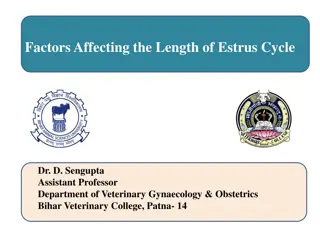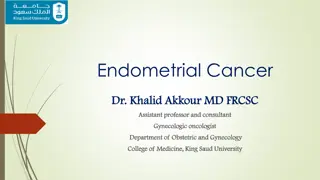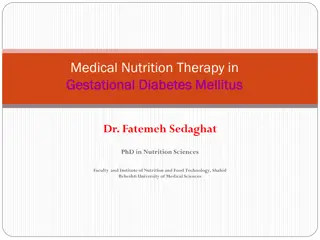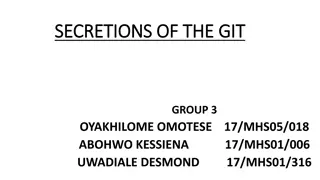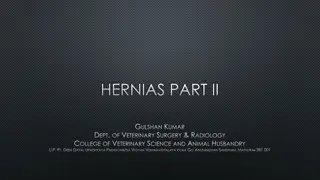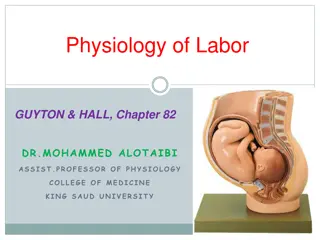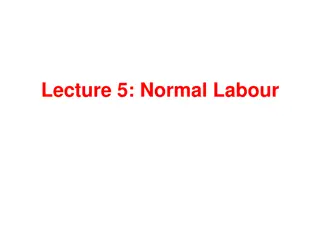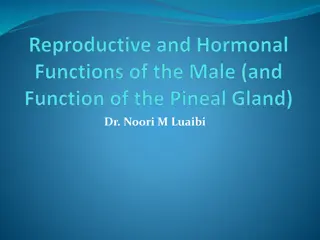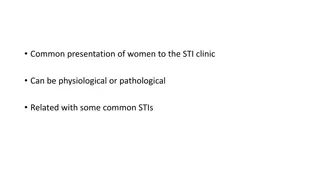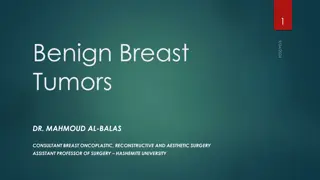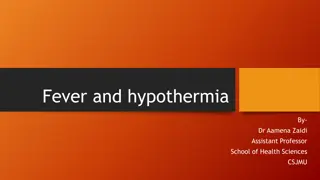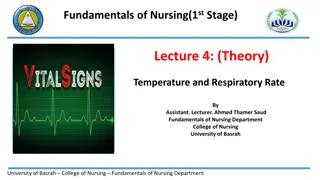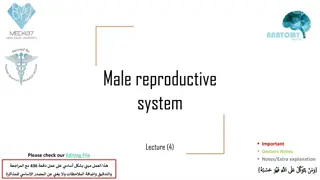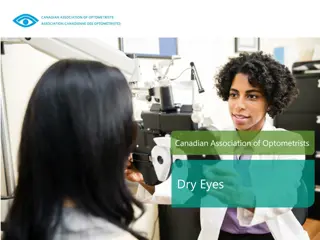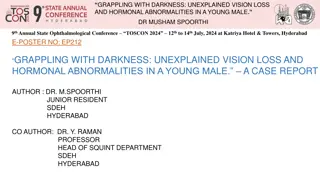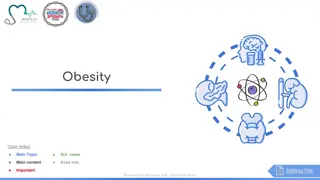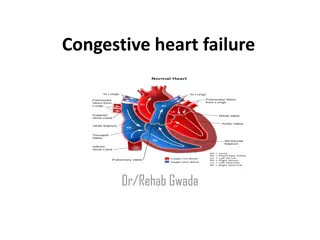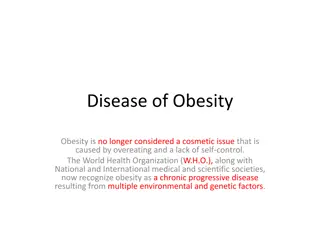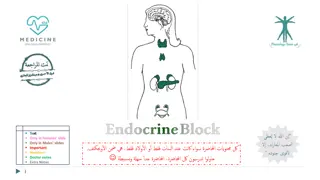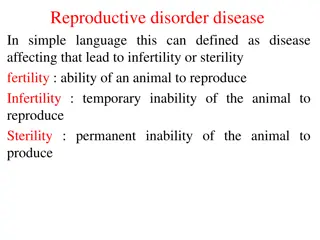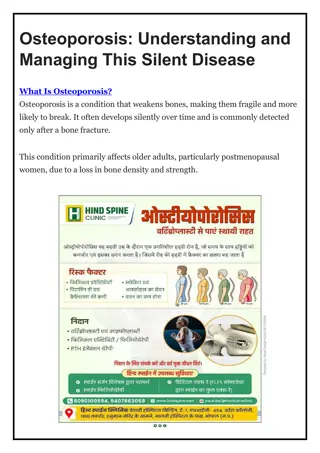Pituitary Disorders
Pituitary disorders, often caused by tumors, can disrupt hormone production leading to various symptoms like weight gain, vision problems, and hormonal imbalances. The pituitary gland plays a crucial role in regulating bodily functions through hormone secretion. Factors such as tumor growth, head in
0 views • 25 slides
Understanding Hyperemesis Gravidarum: Causes, Symptoms, and Treatment
Hyperemesis gravidarum is a severe form of nausea and vomiting during pregnancy, affecting around 27% to 52% of women. The condition typically starts between the 6th to 8th week of pregnancy and is linked to hormonal changes. Risk factors include family history, obesity, and young age at pregnancy.
4 views • 10 slides
Birth Control & STI Online Trivia Game - September 2023
Online trivia game on birth control, STIs, and emergency contraceptives with questions ranging from basic knowledge to in-depth details. Topics include hormonal contraceptives, storing condoms, mechanisms of hormonal birth control, and types of contraceptive methods. Players can test their knowledge
0 views • 18 slides
Understanding Combined Hormonal Contraceptives for Family Planning
Explore the world of combined hormonal contraceptives in this informative course. Learn about different methods, effectiveness, benefits, side effects, and eligibility criteria. Discover how to enhance the effectiveness of your chosen method and compare it with other family planning options. Dive in
0 views • 77 slides
Understanding Premenstrual Syndrome (PMS) and Its Impact
Premenstrual syndrome (PMS) is a common condition experienced by many women before their menstrual cycle. Symptoms include bloating, headaches, and moodiness. Cyclic hormonal changes and chemical fluctuations in the brain play a role in PMS. Factors like weight, exercise, stress, and diet can worsen
1 views • 38 slides
Understanding Factors Influencing Estrus Cycle Length in Veterinary Science
Factors affecting the length of estrus cycle in animals, such as luteolysis, endocrine control, release of PGF2, and hormonal regulation, play crucial roles in determining the cyclicity and fertility of female animals. This comprehensive study delves into the intricate mechanisms involved in estrus
0 views • 17 slides
Hormonal Control in Animals: GCSE Biology Lesson
Explore the fascinating world of hormonal control in animals through this GCSE Biology lesson. Learn about hormones, the endocrine system, glands, and their roles in maintaining homeostasis. Understand the advantages and disadvantages of hormonal coordination, and study specific hormones and their f
0 views • 29 slides
Understanding Sexual Dysfunction and Associated Factors
Sexual dysfunction encompasses a range of issues that can affect individuals, with causes including psychological, neurological, hormonal, and relationship-related factors. Evaluating sexual problems involves considering duration, context, and frequency. Psychological causes, such as anxiety and str
0 views • 25 slides
Can Niacinamide Serum Help with Hyperpigmentation Here's What Experts Say
Hyperpigmentation is a common skin concern that affects people of all ages and skin types. Characterized by dark patches or spots on the skin, hyperpigmentation can be caused by various factors, including sun exposure, inflammation, hormonal changes,
0 views • 5 slides
Understanding Hyperemesis Gravidarum: Symptoms, Complications, and Management
Hyperemesis gravidarum is a severe condition in pregnancy characterized by intractable nausea and vomiting, resulting in fluid and electrolyte imbalances, nutritional disturbances, and physical and psychological debilitation. The exact cause is unknown, but factors like hormonal changes, genetics, a
0 views • 22 slides
Understanding Endometrial Cancer: Risk Factors, Diagnosis, and Management
Endometrial cancer, the most common gynecological malignancy in women, presents with abnormal uterine bleeding and affects women mainly during menopause. Risk factors include hormonal stimulation and estrogen levels. Differentiating between types of endometrial cancer can impact treatment decisions.
3 views • 31 slides
Gestational Diabetes Mellitus: Overview and Risk Factors
Gestational Diabetes Mellitus (GDM) is defined as any level of glucose intolerance first detected during pregnancy, affecting approximately 7% of pregnancies globally. In Iran, GDM prevalence varies between 1.3% to 10%. Factors like age, BMI, weight gain, and family history influence GDM development
8 views • 50 slides
Facewash for Pimples — PnkBeauty
Acne is one of the most common skin concerns that affects people of all ages. From hormonal fluctuations to environmental factors, there are numerous triggers that can lead to pesky pimples. However, a well-chosen facewash can make a significant diff
1 views • 6 slides
Understanding Reproductive Disorder Diseases and Hormonal Infertility in Simple Language
Reproductive disorders can lead to infertility or sterility in animals, affecting their ability to reproduce. Causes include anatomical, functional, infectious, and management factors. Hormonal infertility may result from issues like cystic ovaries, delayed ovulation, or inactive ovaries. Conditions
0 views • 14 slides
Types of Birth Control Methods and Their Effectiveness
Explore the different types of birth control available, including abstinence, hormonal methods, barrier methods, and permanent methods. Learn about the effectiveness rates, how they work, and their pros and cons to make an informed decision about contraception. From hormonal options like pills, patc
0 views • 23 slides
Understanding the Secretions of the Gastrointestinal Tract (GIT)
The gastrointestinal tract (GIT) is responsible for digestion, absorption, and secretion through various glands along the alimentary canal. Secretions are stimulated by factors like direct contact, nervous system activation, and hormonal regulation. Hormones released in response to food presence hel
0 views • 7 slides
Understanding Perineal Hernias in Veterinary Surgery
Perineal hernias are a common condition in uncastrated males but can also occur in females and cats. Weakness in the pelvic diaphragm can lead to herniation due to factors like hormonal disorders, prostatic diseases, and rectal issues. The symptoms include swelling in the perineal region, and diagno
0 views • 25 slides
Ecological Factors and Climatic Influences on Plant Life
Ecological factors play a crucial role in shaping the environment for organisms to thrive. This includes living (biotic) and non-living (abiotic) components like climatic factors, edaphic factors, topographic factors, and biotic factors. Climatic factors such as light, temperature, water, wind, and
0 views • 14 slides
Understanding the Physiology of Labor in Pregnancy
Labor, also known as parturition, is the process of uterine contractions leading to the expulsion of the fetus. Various hormonal changes, including increased estrogen levels, play a crucial role in triggering and regulating labor. The progression from a quiescent uterus to active contractions involv
0 views • 29 slides
Physiology of Labor: Onset and Key Hormonal Changes
Labor, or parturition, involves uterine contractions leading to the fetus's expulsion. Factors triggering labor include hormonal changes like increased estrogen and decreased progesterone, which stimulate uterine muscle activity. Telocytes play a role in spontaneous uterine activity, while oxytocin
0 views • 36 slides
Understanding Normal Labour in Pregnancy
Labour is the natural process of expelling a mature foetus from the uterus. Criteria for normal labour include spontaneous expulsion of a single, mature foetus within a reasonable time frame without complications. Various theories explain the onset of labour, such as hormonal factors and mechanical
0 views • 35 slides
Understanding Male Reproductive and Hormonal Functions
The male reproductive system plays a crucial role in spermatogenesis, sexual performance, and hormonal regulation. Spermatogenesis is a complex process involving the formation of sperm cells from spermatogonia, which then mature through distinct stages. The anatomical structures involved, such as th
0 views • 47 slides
Understanding Common Women's Health Issues Related to STIs
Women's presentations at STI clinics can be either physiological or pathological, often associated with common STIs. The physiology of the vulvovaginal area serves as the first line of defense against infections, and the maintenance of a healthy microbiota plays a crucial role in vulvovaginal health
0 views • 99 slides
Understanding Fibroadenoma - A Benign Breast Tumor
Fibroadenomas are common benign breast tumors, with unknown pathogenesis but linked to hormonal factors. They typically present as painless, movable masses and are often diagnosed through ultrasound or mammogram. Management involves monitoring or surgical excision based on size, growth rate, patient
0 views • 48 slides
Understanding Alterations in Genitourinary Function: An Overview
The genitourinary system comprises the urinary and reproductive organs, with the kidneys, ureters, bladder, and urethra playing crucial roles. Maintaining proper function involves factors like renal blood flow, glomerular filtration, tubular function, and urine flow. Nephrons are the functional unit
0 views • 58 slides
Understanding Fever and Hypothermia: Body Temperature Regulation
Body temperature is the balance between heat production and heat loss, crucial for maintaining health. Fever and hypothermia are conditions where body temperature is elevated or decreased respectively. Factors like age, exercise, hormonal levels, stress, and environment can affect body temperature.
0 views • 10 slides
Understanding Body Temperature Regulation in Nursing Practice
Body temperature regulation is a vital aspect of nursing care, involving the balance between heat production and loss. The core body temperature is controlled by the hypothalamus, responding to thermal receptors and hormonal cues to maintain homeostasis. Heat production mechanisms such as metabolism
1 views • 31 slides
Male Reproductive System Overview: Anatomy, Function, and Components
This lecture focuses on the male reproductive system, covering the primary and accessory sex organs, external genitalia, and their functions. Students will learn about the testes, epididymis, vas deferens, seminal vesicles, prostate gland, and more. Details on testicular descent, scrotum anatomy, an
0 views • 15 slides
Understanding Factors and Prime Factors in Mathematics
Explore the concept of factors and prime factors through practical scenarios involving Jedward, stationary supplies, and school choirs. Learn how to find factors of numbers like 18 and 30, identify prime numbers, write numbers as products of prime factors, determine common factors, and calculate low
0 views • 19 slides
Understanding Dry Eye: Causes, Symptoms, and Diagnosis
Dry eye is a common condition that occurs when your eyes do not produce enough tears or produce tears with the improper chemical composition. This can result from various factors such as aging, hormonal changes, medications, and environmental irritants. Symptoms include stinging, gritty sensation, f
0 views • 13 slides
Unexplained Vision Loss and Hormonal Abnormalities in Young Male - A Case Report
A case report presented at the 9th Annual State Ophthalmological Conference TOSCON 2024 discusses a young male patient grappling with unexplained vision loss and hormonal abnormalities. The patient exhibited symptoms of headache, diminished vision in the left eye, and an unusual head-turning behavio
0 views • 6 slides
Understanding Obesity: Risk Factors, Fat Deposition, and Hormonal Control
Obesity is a condition characterized by excess body fat accumulation, impacting overall health and increasing the risk of various complications such as diabetes, heart disease, and cancer. This content delves into defining obesity based on BMI, exploring anatomic and biochemical differences in fat d
0 views • 12 slides
Understanding Congestive Heart Failure: Causes, Pathophysiology, and Management
Congestive heart failure (CHF) is a condition where the heart cannot pump enough blood to meet the body's needs, often caused by conditions like hypertension and coronary artery disease. Factors affecting cardiac output include preload, heart rate, stroke volume, afterload, and contractility. The pa
0 views • 23 slides
Understanding the Disease of Obesity: A Multifactorial Condition
Obesity is no longer considered a cosmetic issue but recognized as a chronic progressive disease influenced by genetic, environmental, and behavioral factors. It requires lifelong treatment due to its costly impact on health and society. The condition is measured using Body Mass Index (BMI) categori
0 views • 48 slides
Understanding Parathyroid Disorders - Calcium Metabolism and Hormonal Regulation
This presentation covers the functions of calcium, calcium metabolism, bone physiology, and hormonal regulation of calcium metabolism focusing on parathyroid hormone, calcitonin, and Vitamin D. It discusses hypo and hyperparathyroidism in detail, including clinical manifestations and treatment optio
0 views • 15 slides
Reproductive disorder disease
Reproductive disorders in animals can lead to infertility or sterility, affecting their ability to reproduce. Causes include congenital, hormonal, nutritional, infectious, and management factors. Congenital or hereditary causes may involve conditions like hermaphroditism, freemartin syndrome, and ov
0 views • 20 slides
Understanding Typical Adolescent Development and Mental Health Concerns
Adolescence is a period marked by significant physical, emotional, and social changes. During early adolescence (10-13), children experience rapid growth and increased privacy needs. In middle adolescence (14-17), teens explore romantic relationships and seek independence. It's crucial to differenti
0 views • 16 slides
Rational Management of Metastatic Castration-Resistant Prostate Cancer: Treatment Insights and Options
Experts discussed various treatment options for a 60-year-old patient with mCRPC, including switching to Lutetium therapy after progression on Apalutamide. Genetic testing, avoiding back-to-back hormonal therapies, and considering novel AR-blockers like Lutetium-PSMA and PARP inhibitors were highlig
0 views • 6 slides
Ayurvedic Phal Ghrit Key To Ending Women’s Hormonal Fluctuations
Punarvasu Ayurveda, a trusted name in holistic healing, brings the potent Ayurvedic Phal Ghrit to life. Crafted with precision, it supports hormonal balance in women, alleviating fluctuations naturally. Enriched with time-tested herbs, \nSourceLink[\
0 views • 5 slides
Osteoporosis - Hind Spine Clinic
Osteoporosis is a condition that weakens bones, making them brittle and prone to fractures. It occurs when bone density decreases due to factors like aging, hormonal changes, poor nutrition, or a sedentary lifestyle. Common fracture sites include the
3 views • 4 slides
